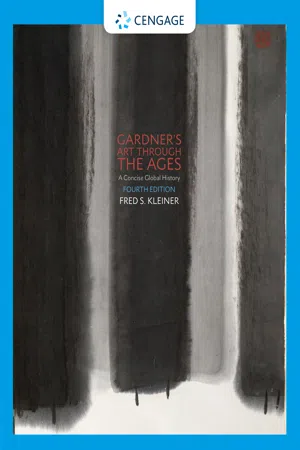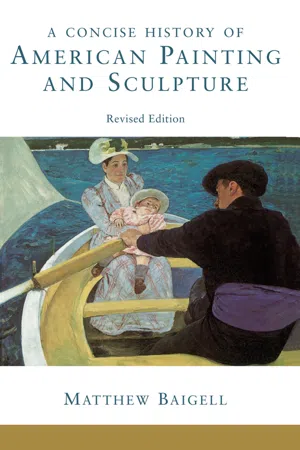History
1920s American Art
The 1920s in American art was characterized by a shift towards modernism, with artists experimenting with new styles and techniques. This period saw the emergence of iconic figures such as Georgia O'Keeffe and Edward Hopper, who captured the spirit of the era through their distinctive interpretations of urban and rural landscapes. The art of the 1920s reflected the dynamism and cultural transformation of American society.
Written by Perlego with AI-assistance
Related key terms
1 of 5
4 Key excerpts on "1920s American Art"
- eBook - PDF
Gardner's Art through the Ages
A Concise Global History
- Fred Kleiner(Author)
- 2016(Publication Date)
- Cengage Learning EMEA(Publisher)
However, in the decades following that new global conflict, American painters, sculptors, and architects often took the lead in establishing innovative styles that artists elsewhere quickly emulated. This new preeminence of the United States in the arts is the subject of Chapter 15. Explore the era further in MindTap with videos of major artworks and buildings, Google Earth ™ coordinates, and essays by the author on the following additional subjects: • André Derain, The Dance ( fig. 14-3A ) ❚ ART AND SOCIETY: Science and Art in the Early 20th Century ❚ ART AND SOCIETY: Primitivism and Colonialism • Arthur Dove, Nature Symbolized No. 2 ( fig. 14-17A ) ❚ ART AND SOCIETY: Art “Matronage” in the United States • Henry Moore, Reclining Figure ( fig. 14-30A ) • José Clemente Orozco, Epic of American Civilization: Hispano-America ( fig. 14-37A ) • William van Alen, Chrysler Building, New York ( fig. 14-41A ) 14-43 Frank Lloyd Wright, Kaufmann House (Fallingwater; looking northeast), Bear Run, Pennsylvania, 1936–1939. Perched on a rocky hillside over a waterfall, Wright’s Falling- water has long, sweeping lines, unconfined by abrupt wall limits, that reach out and cap-ture the expansiveness of the natural environment. Copyright 2017 Cengage Learning. All Rights Reserved. May not be copied, scanned, or duplicated, in whole or in part. Due to electronic rights, some third party content may be suppressed from the eBook and/or eChapter(s). Editorial review has deemed that any suppressed content does not materially affect the overall learning experience. Cengage Learning reserves the right to remove additional content at any time if subsequent rights restrictions require it. MODERNISM IN EUROPE AND AMERICA, 1900 TO 1945 Dalí, The Persistence of Memory, 1931 Gropius, Bauhaus, Dessau, 1925–1926 THE BIG PICTURE Boccioni, Unique Forms of Continuity in Space, 1913 Douglas, Noah’s Ark, ca. - eBook - PDF
- Martin Halliwell(Author)
- 2007(Publication Date)
- EUP(Publisher)
44 This turn from abstraction was a sure sign that artists were thinking for themselves, rather than waiting for critics, curators or patrons to graft meaning onto their art. 202 American Culture in the 1950s It is easy to lump together all post-abstract work under the label of pop art, or to include it within the context of the following decade as Thomas Crow does in his book The Rise of the Sixties (1996). But 1960s pop art had a cleaner image than Rauschenberg’s rough assem-blages and Oldenburg’s plaster casts from the late 1950s, and pop artists did not share the collagist’s impulse to recompose different sub-stances. This label also ignores the vitality of American art in the second half of the 1950s: a vitality epitomized by the work of Jasper Johns. The Visual Arts beyond Modernism 203 Flag (1954–5) By the time the twenty-eight year old Jasper Johns held his first solo show in early 1958 he had already helped to shift the parameters of what could be considered a work of art. At that exhibition at the Leo Castelli Gallery, New York City, Johns displayed recent pieces such as Book (a book in a boxed frame over-painted with wax), Canvas (a small canvas glued on a larger one, both painted grey) and Drawer (the front panel of a drawer appears in a grey painting). Neither of the major art critics of the 1950s, Clement Greenberg and Harold Rosenberg, had much time for Johns and, even though Time was to proclaim a year later that he was ‘the brand-new darling of the art world’s bright, brittle avant-garde’, the general reaction to his 1958 show was that the items on display were humdrum. 45 Some critics could not decide whether his subjects were chosen ‘to make them more visible’ or more obscure, the pictures evoking ‘situations wherein the subjects are constantly found and lost, seen and ignored, submerged and recovered again’. - eBook - ePub
God in the Gallery (Cultural Exegesis)
A Christian Embrace of Modern Art
- Daniel A. Siedell, Robert K. Johnston, William Dyrness(Authors)
- 2008(Publication Date)
- Baker Academic(Publisher)
As art historian Sybil Kantor observed, “Barr’s diary has as many entries on viewing icons as on viewing modern art.” 13 In 1931 Barr published an in-depth review of Russian icons on display at the Metropolitan Museum in New York. Although his Calvinist leanings manifest themselves in his critique of the Russian Church’s “abuse” of icons by encouraging “superstition of the most primitive order,” Barr lauded the genius of Andrei Rubelev’s Old Testament Trinity with its incomparable “detached authority.” 14 Byzantine icons were formative in Barr’s developing aesthetic of modern art. After his path-breaking exhibitions, “Cubism and Abstract Art” (1936) and “Fantastic Art, Dada, and Surrealism” (1937), the stage was set for New York to become the capital of the modern art world by the 1950s. But what is modern art? Robert Storr, former curator of the Museum of Modern Art, observed, “‘Modernism’ is a term on which no one can agree, but one to which everyone nods in tacit understanding.” 15 Modernism in art has been and remains a cluster of debates, discussions, and arguments. What follows are some general definitions that can provide more nuance to the subject than often comes from Christian commentators. Given the current interest (or horror) of the contemporary church in the opportunities (or dangers) offered by the arrival of postmodernism, it is important to define the parameters of modernism. As art historian Irving Sandler once told me, “you define modernism in order to get the postmodernism you deserve.” Definitions What makes a work of art modern? 16 Simply put, modern art is art that is produced in the modern era under the conditions of modernity, which are the social conditions and modes of experience that are seen as the effects of the process of modernization in the West: the range of technological, economic, and political processes associated with the industrial revolution - eBook - ePub
A Concise History Of American Painting And Sculpture
Revised Edition
- Matthew Baigell(Author)
- 2018(Publication Date)
- Routledge(Publisher)
Evergood, and others, he found that neither current events nor strong political themes offered artists viable subject matter any longer. No doubt the psychological and emotional effects of World War II prompted these artists to question the assumptions of their art—leading some, such as Burchfield, into a private world of identification with natural forces; others, such as Shahn, into a broad humanitarianism; Evergood into either poetic fantasy or gentle satire; and Guglielmi into a more rationally conceived world of abstract images, over which the artist exercised total control. In a still not clearly understood way, their paintings275 . Peter Blume, Light of the World, 1932. The Whitney Museum of American Art.276 . O. Louis Guglielmi, View in Chambers Street, c. 1936. The Newark Museum.of the 1940s, and even those of the 1930s, helped undercut the premises of realistic figurative art because the artists wanted their work to carry meanings far beyond recorded visual experiences. The complex content of their work, unlike that of, say, Sloan, Bellows, and Marsh, often contained political, racial, economic, or intensely personal meanings, which required nonrealistic dislocations of space, arbitrary colors, and bizarre as well as disjointed figurai arrangements. Such uses of art might have contributed to the rising interest in abstract art toward the end of the decade.In any event, despite overwhelming public and critical approval of American Scene and realistic painting, abstract art did exist and flourish during the 1930s. Major European artists, such as Hans Hofmann and Josef Albers, immigrated in 1931 and 1933, respectively, and Fernand Léger and Jean Hélion visited the United States for various periods of time. The Gallery of Living Art, the Museum of Modern Art, and the Museum of Non-Objective Art (The Solomon R. Guggenheim Museum) were founded in New York City in 1927, 1929, and 1937, respectively. Major exhibitions of major movements and significant artists were held with increasing frequency. Americans, when abroad, became familiar with, and even joined, such important European modernist groups as the Cercle et Carré (1929–30) and the Abstraction-Creation-Art non-figuratif
Index pages curate the most relevant extracts from our library of academic textbooks. They’ve been created using an in-house natural language model (NLM), each adding context and meaning to key research topics.



